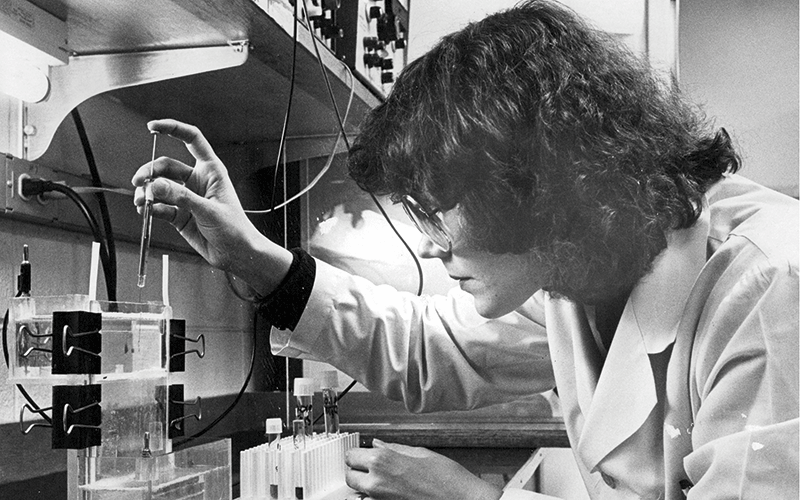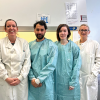The final instalment of a short series, which briefly reviews the historical developments in cancer treatment, covering recent approaches, such as targeted therapy and genetic profiling.

Despite the successes achieved with a wide range of chemotherapeutic agents that used a variety of different mechanisms to destroy cancer cells, there were still significant limitations for both oncologists and patients in the clinical service available during the early 1970s. It was also recognised that the response of murine models of leukaemia and solid tumours were not reliably applicable to human tumours and were poor predictors of often lengthy clinical trials.
New strategies were required to attempt to improve this position and advances in our knowledge of cellular mechanisms. Notably, cell surface receptors and signalling pathways combined with technological progress
in monoclonal antibodies provided a promising and novel approach.
Firstly, early general variations on combined cancer therapy are briefly described with their intended purpose and limitations.
Adjuvant therapy
This is an additional therapy given following main line treatment of cancer, usually surgery, to attempt to avoid a relapse suggested by tumour grade or lymph node status and to eliminate metastatic disease. This approach tends to originate from the landmark randomised clinical trials (RCT) conducted by US surgeon and breast cancer pioneer Bernard Fisher at the University of Pittsburgh and Gianni Bonadonna, consultant in medical oncology in Milan, and colleagues.
After a number of RCTs starting in 1971, it was first reported in 1985 to be of clinical benefit and confirmed subsequently in 2000 with reports from the National Institute of Health in the US and by Richard Peto and colleagues at the Radcliffe Infirmary, Oxford, in the UK.
These reports revealed that the complex and sometimes controversial studies showed that adjuvant therapy, with a combination of chemotherapy agents and early conservative surgery, led to a substantial reduction in breast cancer deaths in the US and UK both in middle age and, to a lesser extent, in old age. In 2005, Bonadonna published an enlightening review of the progress achieved in breast cancer adjuvant therapy.
These studies encouraged a more common use of adjuvant therapy in combination with chemotherapy and other modalities, such as immunotherapy, hormone therapy and radiation. It has been applied with varying degrees of success in colorectal cancer, pancreatic cancer, ovarian and testicular cancer. It is not without side effects, notably vomiting, nausea, alopecia, mucositis and myelosuppression (neutropenia), and risk factors must be carefully balanced with benefit to the quality of life.
Neoadjuvant therapy
Use of chemotherapy, immunotherapy, hormone therapy or radiation prior to surgery or radiotherapy aims to shrink and downstage the tumour and produce clearer margins to permit less invasive surgery, preserve organs and improve patient survival. It will also act on the primary tumour and possibly distant micrometastases and may improve postoperative recovery. However, side effects may be serious and jeopardise or cancel surgery – this obviously must be risk balanced. Neoadjuvant therapy is typically given for inoperable breast cancer, colorectal cancer and non-small cell lung cancer with significant survival benefits. Many other cancers are under evaluation and in some conditions radiotherapy alone or combined with chemotherapy precede surgery. A large number of phase III clinical trials with neoadjuvant therapy have been performed, but, despite high initial response rates, unfortunately these are not maintained with only modest extensions in patient survival. Analysis of nine recent randomised studies of almost 4000 women with breast cancer show little survival advantage in the choice of adjuvant or neoadjuvant therapy.
The role of neoadjuvant therapy, both hormonal and chemotherapy, in prostate cancer has been well reviewed and concluded that the choice may be patient-dependent, but foresaw an increasing role for primary chemotherapy. The side effects of neoadjuvant therapy are much the same as adjuvant therapy described above.
Need for change in chemotherapy
In the previous articles covering the period up to the mid-1970s, attack mechanisms on the cancer cell were directed against nuclear DNA and enzymes involved in nucleoside base synthesis (methotrexate, 5 fluorouracil), induction of structural changes in DNA (alkylating agents) or interference in the process of mitosis (vinblastine). This was in line with attempts to slow down, disrupt or prevent the uncontrolled and excessive proliferation of cancer cells and spread of such cells to other secondary sites and was related to the state of knowledge of cancer cell biology at those times.
Hallmarks of cancer biology
In 2011, Hanahan and Weinberg reviewed six biological hallmarks in the development of human tumours and the specific properties of the cancer cell compared to normal cells. These include sustaining proliferating signalling, evading growth suppressors, resisting cell death, achieving replicative immortality, inducing angiogenesis and activating invasion and metastasis. Some of these biological hallmarks have become targets for molecular targeted cancer therapy.
Epidermal growth factors and receptors
During the 1980s, molecular and genetic research in cellular biology discovered signalling pathways, which regulate a range of cellular activities, including proliferation and survival. Many of these networks were found to be altered in cancer cells. Pioneer research in the late 1950s by Nobel laureates US biochemist Stanley Cohen and Italian neurobiologist Rita Levi-Montalcini at Washington University, St Louis, led to their discovery of the existence of growth factors, notably epidermal growth factor (EGF) and Cohen purified and established its chemical structure. Later, Cohen proposed a specific surface receptor (EGFR), now known to activate an intracellular cascade found to involve tyrosine kinase and the resultant product binds to promoter regions of relevant genes stimulating cell cycle regulating processes, such as cell division, differentiation and programmed cell death.
EGFR1 is now known to be a 170kDa transmembrane protein with an extracellular ligand binding domain, lipophilic region and an intracellular protein tyrosine kinase domain. The EGFR surface membrane protein is overexpressed in various cancers with increased proliferation and a potential for metastatic spread.
Monoclonal antibodies against EGFR1-(HER1)-Cetuximab
US physician-scientist John Mendelsohn and his colleague cell biologist Gordon Sato led a research team at the University of California, San Diego to develop a monoclonal antibody to prevent EGF binding with EGFR1 in cancer cells. In 1984, an effective monoclonal antibody (C225) was achieved and was further developed by Yeda Technology Research (Israel) as Cetuximab (Erbitux) in 1988 and later manufactured and supplied by Eli Lilly.
Cetuximab is a recombinant chimeric (mouse/human) IgG monoclonal antibody prepared from human A431 epidermoid carcinoma cells as immunogen, which inhibits EGF binding and has been used, often as combined immunotherapy, in the treatment of metastatic colorectal cancer, non-small cell lung cancer with metastases and head and neck cancer and was approved by the Federal Drug Administration (FDA) for colorectal cancer in 2004 and head and neck cancer 2006. Tumours with a KRAS mutation, detectable by a PCR FDA approved procedure resist effective treatment with cetuximab. Side effects of cetuximab include a characteristic rash, diarrhoea, vomiting and infections affecting the respiratory system, skin and mouth.
Monoclonal antibodies against EGFR2-(HER2)-Trastuzumab (Herceptin)
German cancer researcher Axel Ullrich working at Genentech, a Northern Californian science technology company, first described the HER2 protein in 1986 and his findings were confirmed a year later by many others, including US oncologist Dennis Slamon and colleagues at UCLA who proposed that the HERS2 gene responsible for HERS2 protein may be associated with cancer and US cancer biologist Stuart Aaronson at US National Cancer Institute showed that the HERS2 protein stimulates cell proliferation and survival via a signalling cascade. HERS2 is a member of the epidermal growth factor family, the HERS2 gene is located on chromosome 17 which encodes for an 185kDa transmembrane protein, which is produced in excess if a specific gene mutation is present. It was found that HER2 protein is increased (positive) in 20-30% of breast cancer tumours and associated with more aggressive tumours, a high recurrence rate and increased mortality.
With further research and development at several centres, including the University of Texas, UCLA and collaboration with Genentech, a monoclonal antibody was developed targeting HERS2 to induce an immune-mediated response to suppress the growth of HERS2 receptor positive tumours, first in mice then modified as Trastuzumab (Herceptin) as a specific immunotherapy agent in humans cancer therapy.
At least three successful clinical trials were performed in the mid 1990s. Current NICE guidelines indicate that trastuzumab treatment is appropriate for early breast cancer and metastatic breast cancer as monotherapy or in combination with chemotherapy agents or tamoxifen endocrine therapy. A large number of clinical trials are ongoing to find the optimal combination therapy and it was approved by FDA in 2006 for breast cancer.
When used alone, myelosuppression, nausea and sickness are rare, but in combination therapy fever, neutropenia, skin rash and flu-like symptoms may develop. Of more concern are an acute hypersensitivity reaction and that cardiotoxicity may result, affecting left ventricular function, emphasising the need to monitor cardiac function before and during treatment. The clinical use of trastuzumab was well reviewed in 2007 by Clifford Hudis from the Memorial Sloan-Kettering Cancer Centre, New York.
Monoclonal antibodies against Vascular epithelial growth factor receptor-VEGFR -Bevacizumab (Avastin)
It was proposed in the early 1970s by US medical scientist Judah Folkman that angiogenesis was essential for tumour growth and tumours secrete tumour angiogenic factors. Angiogenesis is the creation of new blood vessels essential to tumour development, cancer cell functions and tumour growth. Anti-angiogenic agents tend to be cytostatic, rather than cytotoxic and consequently tend to be used in adjuvant therapy with radiotherapy or surgery and may stabilise metastases. Angiogenesis in cancer depends on the migration of endothelial cells to the tumour site followed by their proliferation to form effective blood vessels. Vascular epithelial growth factor (VEGF) is a cytokine, a polypeptide that binds to transmembrane receptors on endothelial cells to stimulate the formation of new blood vessels. VEGF was first described in 1983 in laboratory animals by Donald Senger and colleagues at Beth Israel Deaconess medical centre and Harvard Medical School in the US. Italian-US molecular biologist Napoleone Ferrara discovered human VEGF in 1989 while at Genentech and developed the first antibody to VEGF which led to the development of bevacizumab in 2004. Several VEGFs have now been identified and VEGF-A appears significant in cancer binding to two tyrosine kinase receptors on endothelial cells to activate processes promoting angiogenesis, vascular permeability, cell migration and gene expression. High VEGF and receptor overexpression is associated with many aggressive cancers with poor rates of survival. Bevacizumab is a humanised murine monoclonal antibody that blocks binding of VEGF-A, thus inhibiting the signalling pathway to angiogenesis. It has been used in combination chemotherapy in colorectal cancer, lung, breast, renal and ovarian cancer. Reported side effects include possible interference in wound healing and natural processes in dealing with atherosclerosis, hypertension and risk of bleeding. Extreme effects include bowel perforation and fatal osteonecrosis of jaw. There is some evidence that in some cases positive initial responses are transitory followed by progression with little survival benefit. A number of resistance theories have been proposed including evasion by revasculature and protection of tumour vasculature and the development of mutations to combat the VEGF inhibitor.
Small molecular agents against EGFR tyrosine kinase Gefitinib & Erlotinib
Highly selected small chemical agents that are <500Da may pass the plasma membrane and inhibit tyrosine kinases and intracellular proteins and a systematic search for candidate EGFR tyrosine kinase inhibitors was first performed in 1988 by a research team led by P Yaish at Jerusalem University. This approach led to the synthesis of Gefitinib (Iressa) a low molecular weight compound, chemically anilinoquinazoline, marketed by AstraZeneca. It is an orally active selective inhibitor of EGFR tyrosine kinase domain at its ATP binding site which blocks the RAS signalling cascade, which otherwise in certain cancers leads to uncontrolled cell proliferation. Tyrosine kinases are a family of enzymes that catalyse phosphorylation of select tyrosine residues in target proteins using ATP. Tests are available on tumour tissue from Genzyme and QIAGEN for EGFR mutations in order to predict which patients will respond to Gefitinib treatment. It was approved in Europe 2009 as the first line treatment of non-small cell lung cancer (NSCLC).
The Iressa Pan-Asia clinical trials in 2009 and 2014 confirmed improved progression free survival and tolerance, but it is only effective for only 10% of these patients who have this form of mutated or overexpressed EGFR. It has also been used for metastatic head and neck cancer, breast and ovarian cancer. A facial rash is associated with a positive response to treatment, other side effects include nausea, vomiting and diarrhoea, which is also more severe in a small number of patients.
Other examples include Erlotinib (Tarceva), which can be used in the treatment of NSCLC and pancreatic cancer. Similar profile to Gefitinib relating to survival benefit from the 2009 Saturn trials comparing Erlotinib to alternative chemotherapy.
Inhibition of fusion protein tyrosine kinase activity-Imatinib mesylate
The hallmark of virtually all patients with chronic myeloid leukaemia (CML) is the presence of the Philadelphia chromosome, which results from a reciprocal translocation between chromosomes 9 and 22. As a consequence a fusion protein, termed BCL-ABL, is formed which has tyrosine kinase activity. Research commencing in the early 1990s by Ciba Geigy (later Novartis) synthesised agents to target inhibition of the enzyme to suppress the excessive clonal cell expansion. US physician scientist Brian Druker led a team from Oregon Health and Science University with researchers from Novartis in landmark studies and by 1996 had demonstrated that “ST1571” (Imatinib mesylate ITB or Gleevec) was a safe and effective inhibitor of kinase BCL-ABL, acting by competitive of the ATP binding site of tyrosine kinase, blocking BCL-ABL signal transduction.
In addition, ITB also inhibits the KIT tyrosine kinase and platelet derived growth factor receptor tyrosine kinase, which has been found to be effective in the treatment of gastrointestinal stromal tumours. In subsequent clinical studies, initially with a small group of 84 patients in late stage CML in which interferon therapy had failed, during the study period 1998-2000, ITB achieved over 98% haematological remission and white cell counts returned to normal within one month.
Further clinical trials demonstrated improved long-term results over six years for response, survival and safety of ITB and hailed as a milestone in the development of innovative treatment as the first example of a drug designed to block a known oncogene. Side effects observed include nausea, oedema, myalgias and diarrhoea, most often mild. A minority of patients fail to respond with ITB, ABL mutations alter ITB binding or favour kinase conformations associated with clinical resistance. Alternative second generation inhibitors, such as dasatinib and nilotinib, offer much promise in overcoming such resistance.
Small molecule proteasome inhibitors (PI)-Bortezomib
Proteasomes were first described in late 1970s and are multi enzyme complexes, which regulate other cellular proteins and degrade and recycle proteins which are damaged or no longer required. These proteins are repeatedly “tagged” by a small protein ubiquitin for degradation, this ubiquitin proteasome system (UPS) has been considered a possible target for cancer therapy as it regulates cell cycle progression, supports survival, stimulates growth and reduces apoptosis. Thus inhibition may induce cell cycle arrest, reduce proliferation, apoptosis in myeloma cell lines and decreases cytokine secretion in bone marrow, and inhibits nuclear factor activity.
Bortezomib (Velcade) is a low molecular weight boronic dipeptide that acts as a selective inhibitor of the proteasome and was first synthesised in 1995 as PS-341 and tested in a small phase 1 clinical trial on patients with multiple myeloma and further developed by Millennium Pharmaceuticals (Cambridge, US) in 1999. It was approved by FDA in 2003 based on SUMMIT phase II trial despite the 35% rate of response to treatment in more difficult cases. It has also been used in renal carcinoma, it is infused i.v and has side effects, such as peripheral neuropathy and to improve tolerance and overcome bortezomib resistance second generation PIs have been developed for example oprozomib.
Genomic profiling (GNP)
The discovery of the BRCA1 gene encoding for a DNA repair enzyme associated with increased risk of breast cancer when mutated was reported in 1990 by a research team at University of California at Mary-Claire King’s laboratory. The use of DNA technology since that time to identify mutations to aid diagnosis, prognosis and treatment has grown exponentially, particularly with the development of high-throughput DNA and RNA technology systems, such as next generation sequencing. In this context, genomic profiling can be defined as the use of such technology to identify genes and mutations which may be used to predict a positive response to cancer chemotherapy, customised to the patient’s own tumour tissue.
Currently, there are at least four GNP systems to provide physicians with information for personalised breast cancer patient treatment plans. These include EndoPredict (Myriad Genetics) examining 12 genes on RNA extracted from formalin fixed paraffin embedded breast tumour tissue.
FoundationOneCDX (Cambridge, US) is a 2017 FDA-approved GNP, which can identify 324 genes and two types of genomic alterations in any type of solid tumour tissue, allowing diagnostic tests for 15 different targeted therapies for cancers, such as non-small cell lung cancer, melanoma, breast cancer and colorectal cancer.
GNP in cancer treatment has also been reported in pancreatic, prostate cancer and acute myeloid leukaemia. This quite complex subject has been well reviewed and is recommended for interested readers.
Concluding comments
There is little doubt that progress has been made in our understanding of cancer biology and a wide range of anti-cancer agents are available. Outstanding contributions have been made by Bernard Fisher, Gianna Bonadonna, Stanley Cohen, Rita Montalcini, John Mendelson, Gordon Sato, Dennis Slamon, Napoleone Ferrara and Brian Druker, as described. Resistance effects in therapy are of great concern and mean that research continues to develop second- and third-generation tyrosine kinase inhibitors. Despite the direct target approach of genomic profiling, its full potential has not been realised in many cancers, with an apparent lack of hard evidence of benefit and the difficulties of matching an ideal anti-cancer agent to the profile. Battles have been won, but the war on cancer continues for researchers, oncologists and patients.
Stephen Clarke is a retired IBMS Fellow.
To see the references, view the article online at the biomedicalscientist.net




